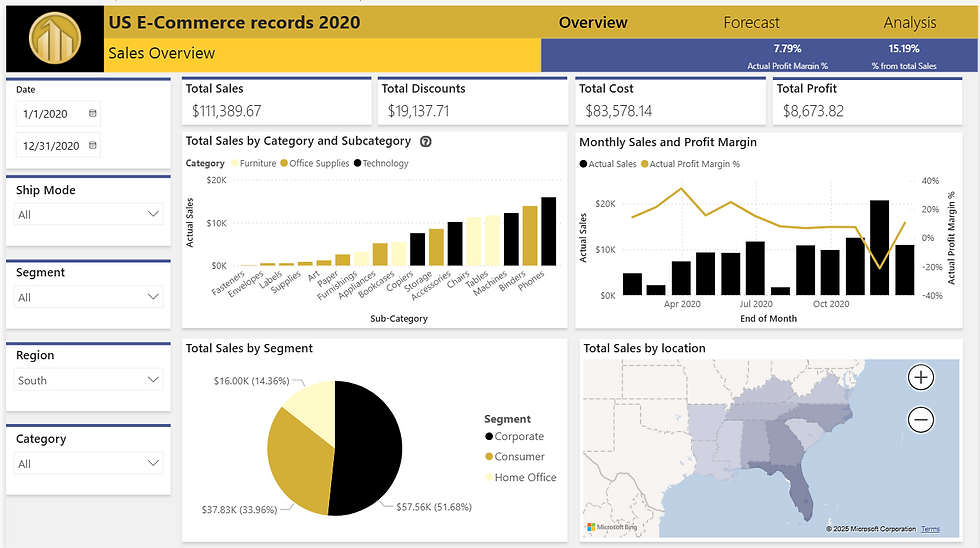Top 5 Mistakes Egyptian Businesses Make in Power BI Implementation and How to Avoid Them
- Mounir Maurice

- Jul 10
- 4 min read
Power BI has become an indispensable tool for businesses looking to make data-driven decisions. In Egypt, many organizations face unique challenges as they integrate this powerful software into their operations.
Common pitfalls can hinder effective use, but understanding them can help businesses harness the full potential of Power BI. Below, we outline the top five mistakes often made during Power BI implementation and how to successfully avoid them.
Starting Without a Data Strategy

One major mistake organizations often make is diving into Power BI implementation without a comprehensive data strategy.
A significant percentage, around 60%, of businesses that skip this step report confusion regarding data sources and the metrics that matter most. Instead of launching into dashboard creation, define a data strategy first.
Actionable Steps:
Organize a data strategy workshop to clarify your key performance indicators and outline your data sources.
Engage with experts, such as Stratemedia, to ensure that your reporting meets executive objectives.
By establishing clear goals upfront, your organization can create targeted dashboards that align with your business vision.
Treating Power BI Like Excel
Viewing Power BI merely as an advanced version of Excel is a misconception that many companies hold.
This view leads to simply translating spreadsheet logic into Power BI without using its unique capabilities, such as relationships, data modeling, and DAX (Data Analysis Expressions).
Solution:
Invest in Power BI training that emphasizes the differences between the two. By understanding Power BI's features, you can build robust analytics solutions.
For instance, a marketing team that adopted proper training increased their reporting efficiency by 40%, enabling them to analyze campaign success and ROI more effectively.
Overloading Dashboards with Visuals
It's tempting to include many visuals in Power BI dashboards, but this often leads to clutter and confusion. Studies show that users can experience a 40% decrease in their ability to derive insights from overloaded dashboards.
Best Practice:
Focus on data storytelling principles. Select a few relevant visuals and utilize features like bookmarks to improve navigation.
An example is prioritizing key metrics, such as sales performance, instead of displaying every data point. This clarity can enhance decision-making and user engagement with your dashboards.
Ignoring Data Governance
A common oversight is neglecting data governance during and after your Power BI rollout. Without user roles, permission settings, and audit trails, security threats can compromise data integrity.
To Secure Your Data:
Establish a data governance policy from the beginning.
Utilize features of Power BI, such as Row-Level Security (RLS), to manage user access to sensitive information.
Implementing these measures can protect your data while ensuring that users have appropriate access, ultimately maintaining data integrity and security.
At Stratemedia, we help businesses in Egypt set up or rebuild their data governance frameworks. Ensure the data is accurate, secure, and aligned with the business objectives.
We offer personalized consultation to help you set up data ownership, user roles, access restrictions, and validation standards, whether your business is just starting its digital transformation journey or already using technologies like Power BI.
We use a mix of global best practices and knowledge of the specific operational problems in Egypt to help you set up scalable governance models that support compliance, accurate reporting, and making decisions.
Stratemedia makes sure that your data governance approach is not only defined but also fully operational and focused on adding value.
Not Integrating with Business Workflows
Another frequent mistake is creating Power BI reports in isolation from existing business workflows. This siloed approach can lead to poor adoption rates, diminishing the impact of valuable data insights.
Enhancing Power BI Value:
Work with experts like Stratemedia to design solutions that seamlessly fit into your daily operations. The goal is to integrate analytics into decision-making processes, making them more effective and timely.
For example, a company that aligned their Power BI reports with sales strategy saw a 30% increase in monthly sales, thanks to data-driven decision-making informed directly by the analytics.
ClickUp is a powerful all-in-one productivity platform that helps teams and individuals streamline their workflow management by bringing tasks, docs, goals, time tracking, and communication into one centralized workspace.
Whether you're managing projects, tracking client deliverables, or planning internal operations, ClickUp allows you to create customizable workflows that suit your unique processes.
With features like automation, real-time collaboration, status updates, and integrations with tools like Slack, Google Drive, and Outlook, ClickUp reduces manual work and improves visibility across teams. It’s especially useful for businesses looking to scale operations efficiently while maintaining accountability and focus.
Implementing Power BI for Business Intelligence Success
Power BI implementation is the process of deploying Microsoft’s business intelligence platform within an organization to transform raw data into meaningful insights. It involves more than just creating dashboards—it starts with identifying business goals, connecting and cleaning data from multiple sources, designing a scalable data model, and building visual reports that align with key performance indicators (KPIs).
A successful implementation also includes setting up governance rules, user roles, and security layers to ensure data accuracy and access control. Power BI implementation can empower organizations to make faster, data-driven decisions, whether for a single department or enterprise-wide reporting, when guided by a structured strategy and the right consulting support.
Wrapping Up
By understanding and addressing these five common mistakes, Egyptian businesses can turn Power BI into a strategic asset rather than a burden. Starting with a clear data strategy, leveraging Power BI's unique features, maintaining clarity in dashboard design, ensuring robust data governance, and integrating insights into workflows are all critical steps for success.
Emphasizing these best practices not only boosts the effectiveness of your Power BI implementation but also positions your organization to thrive in today's data-driven world. Be proactive in these areas, and you will empower your teams to make informed decisions that lead to meaningful business outcomes.






Comments